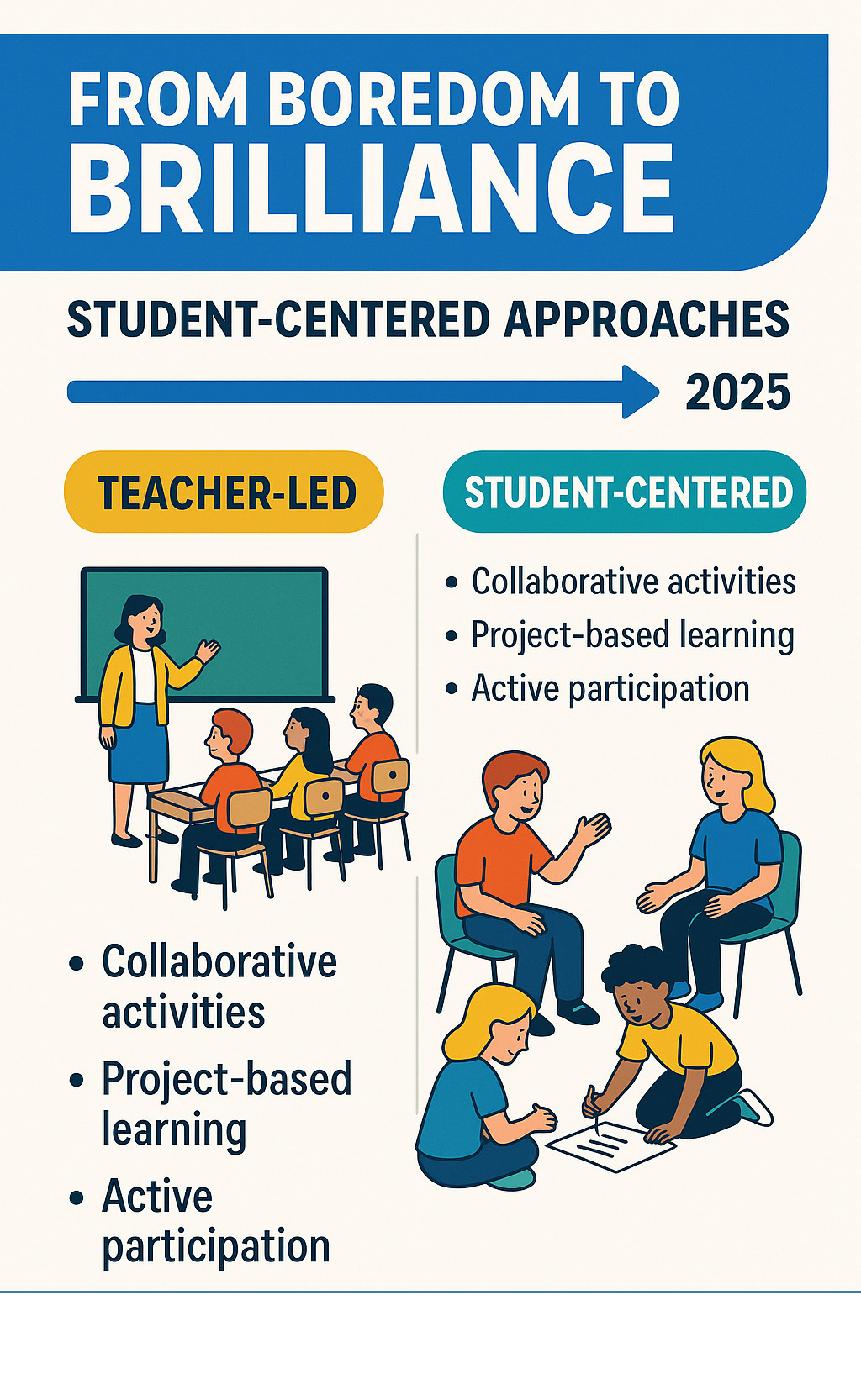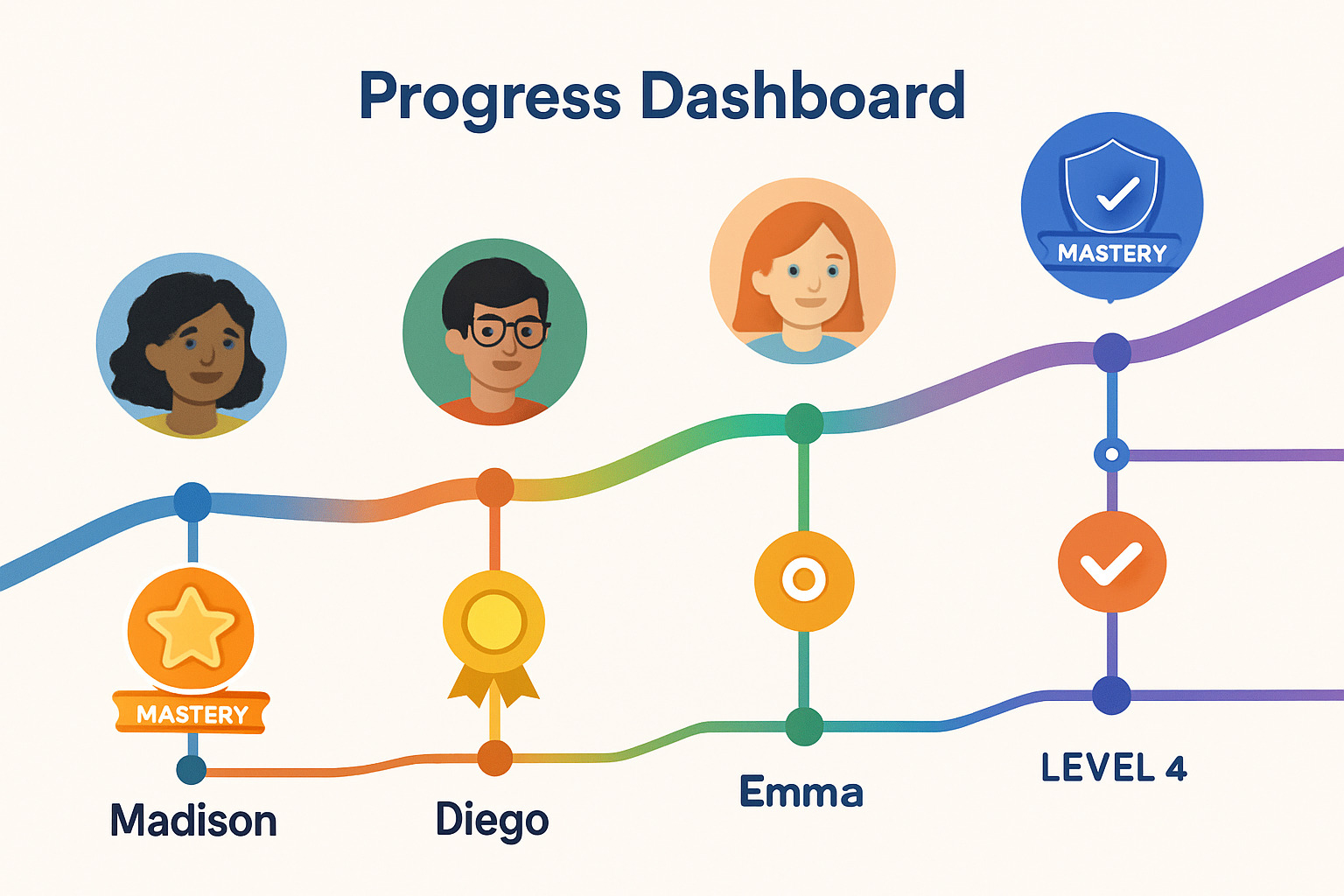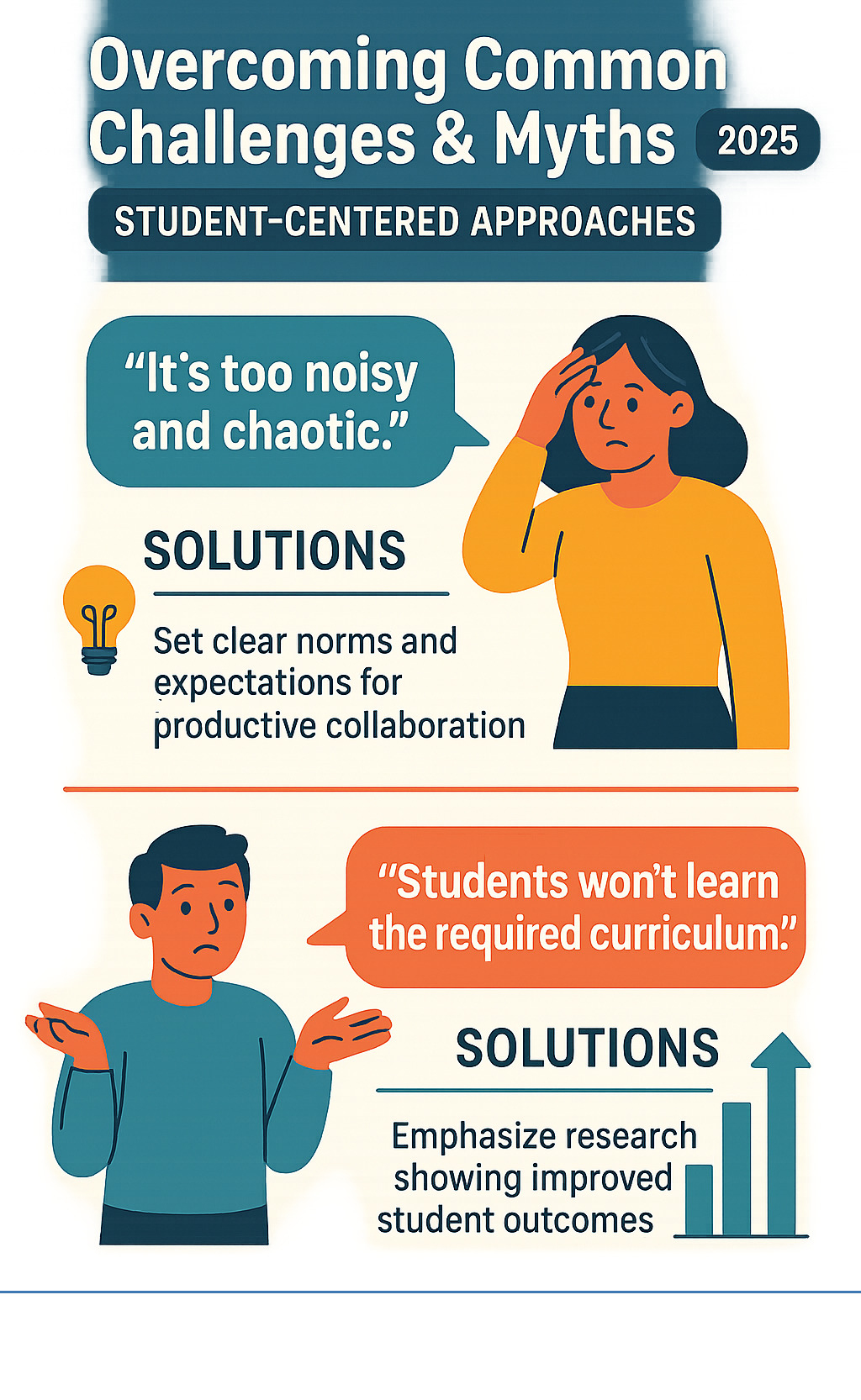
Why Student-Centered Approaches Are Changing Education
Student centered approaches put learners at the heart of their educational journey, shifting from traditional teacher-led instruction to methods where students actively drive their own learning. Here’s what makes these approaches so powerful:
Key Student-Centered Strategies:
- Choice boards and menus – Students select topics and formats that match their interests
- Project-based learning – Real-world problems engage students in meaningful work
- Inquiry circles – Students ask questions and explore answers collaboratively
- Flexible pacing – Learners progress when they master concepts, not by calendar
- Self-assessment – Students reflect on their growth and set personal goals
As one educator noted in recent research: “Too many students describe high school as boring—but it doesn’t have to be.” The solution lies in putting students at the center of their education.
The shift is working. Stanford research shows that students in student-centered schools outperform peers on standardized tests, graduate at higher rates, and complete more college-prep coursework. Even more impressive: 100% of graduates from some student-centered programs go on to college.
This change happens when we stop asking “How can I teach this?” and start asking “How can my student learn this best?”
I’m Peter Panopoulos, and during my 8+ years teaching middle school math in Massachusetts, I witnessed how student centered approaches can turn struggling learners into confident problem-solvers. Now, through A Traveling Teacher, I help families across Massachusetts experience this same change through personalized, one-on-one online tutoring.

Table of Contents
- What Is Student-Centered Learning?
- Core Principles of Student Centered Approaches
- 9 Student-Centered Strategies That Turn Boredom into Brilliance
- Overcoming Common Challenges & Myths
- Impact on Engagement, Motivation, and Achievement
- Frequently Asked Questions
What Is Student-Centered Learning?
Student-centered learning is an educational approach where learners choose not only what to study but also how and why they learn it. Unlike traditional teacher-centered instruction, student centered approaches position students as co-creators of their educational experience.
At its core, student-centered learning is built on constructivist theory—the idea that learners actively build knowledge by connecting new information to their existing understanding. This approach recognizes that students learn best when they can direct their own learning journey, set their own pace, and pursue topics that genuinely interest them.
The key elements include:
- Autonomy: Students make meaningful choices about their learning
- Relevance: Content connects to students’ lives and interests
- Personalized pacing: Learning happens when students are ready, not when the calendar says so
- Active engagement: Students do the thinking, not just the listening
Student Experience Comes First
In student centered approaches, we start with the student’s voice and choice. Research shows that learners find learning more meaningful when topics are relevant to their lives and interests. This means asking students what they want to learn about within the curriculum framework, how they prefer to demonstrate their understanding, and what goals they want to achieve.
We also tap into students’ prior knowledge and experiences. When a student struggling with fractions suddenly connects the concept to splitting pizza slices with friends, that’s the magic of relevance in action. Their background becomes the foundation for new learning.
How It Differs from Traditional Instruction
The contrast between teacher-centered and student-centered classrooms is striking:
| Teacher-Centered | Student-Centered |
|---|---|
| Teacher talks, students listen | Students discuss, explore, and create |
| One-size-fits-all pacing | Flexible, mastery-based progression |
| Memorization and recall | Deep understanding and application |
| Individual competition | Collaborative learning |
| Fixed curriculum sequence | Responsive to student interests |
| Teacher as authority | Teacher as guide and facilitator |
Traditional lecture-based instruction often leaves students passive and disengaged. As research notes, this approach can make students “passive, apathetic and bored.” In contrast, student centered approaches activate learners as partners in their education.
Core Principles of Student Centered Approaches
The most effective student-centered learning environments are built on several foundational principles supported by scientific research on personalization:
Personalization means recognizing that each student learns differently. Some need visual representations, others learn through movement, and many benefit from peer discussion. We adapt our methods to match each learner’s needs.
Mastery-based learning allows students to progress when they’ve truly understood a concept, not when the calendar says it’s time to move on. This prevents the gaps that often accumulate in traditional systems.
Competency-based progress focuses on what students can do with their knowledge, not just what they can remember. Can they apply math concepts to solve real problems? Can they communicate their thinking clearly?
Collaboration recognizes that learning is often social. Students learn from each other, teach each other, and support each other’s growth.
Formative feedback provides ongoing guidance rather than just end-of-unit grades. Students know how they’re doing and what to focus on next.
Principle #1: Relevance Drives Rigor in Student Centered Approaches
When learning connects to students’ lives, they naturally engage more deeply. This doesn’t mean lowering standards—it means finding authentic, real-world applications that make rigorous content meaningful.
For example, instead of abstract math problems, students might analyze local housing costs to understand percentages and statistics. They’re still mastering the same mathematical concepts, but now they see why it matters.
Cultural connections also matter. Students bring rich backgrounds and experiences that can improve everyone’s learning when we create space for those perspectives.
Inquiry-based learning lets students ask the questions that genuinely puzzle them, then guide their own investigation. This natural curiosity drives deeper engagement than any external motivation.
Principle #2: Assessment As Learning in Student Centered Approaches
In student centered approaches, assessment becomes a learning tool rather than just a measurement tool. Students engage in self-assessment, reflecting on their progress and identifying areas for growth.
This might look like students maintaining learning portfolios where they document their thinking, track their progress, and set goals for future learning. They become partners in evaluation rather than passive recipients of grades.
Goal-setting conferences between teachers and students create opportunities for personalized feedback and planning. Students learn to advocate for themselves and take ownership of their learning journey.
9 Student-Centered Strategies That Turn Boredom into Brilliance
Ready to see student centered approaches in action? Here are nine powerful strategies that transform passive learners into engaged, motivated students:
1. Choice Boards & Menus — Let Students Steer
Choice boards give students options for how they engage with content and demonstrate their learning. Think of it like a restaurant menu—students can choose from different “appetizers” (ways to explore a topic), “main courses” (core activities), and “desserts” (extension activities).
Digital tools like Padlet or Trello make this even more dynamic. Students can see all their options, track their progress, and even suggest new activities.
The key is providing structured choice. Students aren’t choosing whether to learn—they’re choosing how to learn. This builds self-direction skills while maintaining academic rigor.
2. Project-Based Learning in the Community
Nothing beats real-world relevance. When students work on projects that matter to their community, they see the purpose in their learning. A middle school class might research local environmental issues and present solutions to the city council. High schoolers could develop apps to solve problems they’ve identified in their neighborhood.
These projects create authentic audiences for student work. Instead of writing reports that only the teacher reads, students present to community members, publish their findings online, or implement real solutions.
The problem-solving skills students develop through community-connected projects prepare them for college and careers in ways that traditional assignments simply can’t match.
3. Inquiry Circles & Socratic Seminars
Small group discussions where students drive the conversation develop critical thinking and communication skills. In inquiry circles, students come prepared with questions about their reading or research, then explore those questions together.
Socratic seminars take this further by having students lead discussions about complex texts or issues. They learn to build on each other’s ideas, ask probing questions, and think deeply about important topics.
These formats shift the cognitive load from teacher to students. Instead of the teacher asking all the questions, students become the questioners and critical thinkers.
4. Flexible Digital Tools for Anytime Practice
Technology can make learning more personalized and accessible. Platforms like Nearpod allow teachers to create interactive lessons where students can work at their own pace, get immediate feedback, and access support when they need it.
Real-time data dashboards help teachers see exactly where each student stands and provide targeted support. If three students are struggling with the same concept, the teacher can quickly form a small group for additional instruction.
For families in Massachusetts seeking this kind of personalized support, online tutoring provides the flexibility and individualization that makes student centered approaches so effective.
5. Goal-Setting Conferences
Regular one-on-one conferences between teachers and students transform the teacher’s role from instructor to coach. Students reflect on their progress, identify challenges, and set goals for future learning.
These conversations help students develop metacognitive skills—thinking about their thinking. They learn to identify their learning preferences, recognize when they need help, and advocate for what they need.
Formative check-ins throughout the learning process keep students on track and provide opportunities for course correction before problems become overwhelming.
6. Gamified Mastery Pathways

Gamification taps into students’ natural motivation by providing clear progress indicators, achievement badges, and level-based advancement. Unlike traditional grades, these systems celebrate growth and mastery.
Students can see exactly what they’ve accomplished and what comes next. Progress bars and achievement badges provide intrinsic motivation—students want to advance because they can see their growth, not because they’re competing against others.
The key is focusing on mastery rather than speed. Students advance when they’ve truly learned the material, creating a strong foundation for future learning.
7. Peer Teaching & Feedback Rounds
When students teach each other, both the teacher and learner benefit. The student doing the teaching deepens their own understanding, while the learner gets explanations from someone who recently mastered the same concept.
Structured peer feedback rounds help students develop communication skills and learn to give and receive constructive criticism. They might review each other’s writing, provide feedback on presentations, or collaborate on problem-solving.
This collaborative approach builds leadership skills and helps students develop metacognitive awareness as they explain their thinking to others.
8. Choice of Final Product Formats
Instead of everyone writing the same five-paragraph essay, students might choose to create videos, podcasts, infographics, or even Minecraft builds to demonstrate their understanding. This allows students to play to their strengths while still meeting learning objectives.
The key is ensuring that all formats require the same level of thinking and demonstrate the same learning standards. A student creating a video about the Revolutionary War should show the same historical understanding as one writing a traditional report.
This creativity and choice often leads to higher quality work because students are more invested in formats that appeal to them.
9. Flipped & Blended Micro-Lessons
Short instructional videos allow students to learn new concepts at their own pace, pausing and replaying as needed. Class time then becomes focused on application, discussion, and problem-solving.
Research on blended learning shows that this approach can be particularly effective when combined with personalized support. Students get the direct instruction they need while also having opportunities for hands-on practice and peer collaboration.
Self-pacing is crucial here. Students can spend more time on challenging concepts and move quickly through material they already understand.
Overcoming Common Challenges & Myths

Many educators and parents worry about implementing student centered approaches. Let’s address the most common concerns:
“It’s too noisy and chaotic.” Student-centered classrooms are often more active and collaborative, but this doesn’t mean they’re unstructured. Clear norms and expectations create productive learning environments where students can work together effectively.
“Students won’t learn the required curriculum.” Research consistently shows that students in student-centered environments actually outperform their peers on standardized tests. The Stanford study found that students in student-centered schools had higher achievement gains in both English and math.
“It takes too much time to plan.” While the initial shift requires investment, student-centered approaches often become more efficient over time. When students take ownership of their learning, teachers can focus on facilitating rather than constantly directing.
“Not all students can handle the responsibility.” Like any skill, self-direction develops with practice and support. Students who initially struggle with choice and autonomy grow into confident, independent learners when given appropriate scaffolding.
Practical Fixes for Teachers New to Student Centered Approaches
Start small and build gradually. You don’t need to transform your entire teaching practice overnight. Try implementing one student-centered strategy at a time:
Week 1: Introduce choice boards for one assignment
Week 2: Add a brief goal-setting conference with each student
Week 3: Try a Socratic seminar discussion format
Week 4: Implement peer feedback on a project
Clear norms and expectations are crucial. Students need to understand what productive collaboration looks like, how to give constructive feedback, and what kinds of choices are available to them.
Structured choice prevents overwhelm. Instead of unlimited options, provide 3-4 high-quality choices that all meet the same learning objectives.
Supporting Massachusetts Parents & Students Online
For families across Massachusetts, student centered approaches are particularly powerful in one-on-one online tutoring settings. Unlike local tutoring centers or learning apps that use standardized approaches, personalized online tutoring can provide the individualized attention and flexible pacing that makes student-centered learning so effective.
At A Traveling Teacher, we’ve seen how this individualized approach transforms students’ confidence and achievement. When students can learn at their own pace, choose topics that interest them, and receive immediate feedback, they develop both academic skills and self-advocacy abilities.
Our flexible scheduling accommodates busy family lives while ensuring students get the support they need when they need it. You can see examples of this change in our testimonials of Massachusetts students who’ve thrived with student-centered online tutoring.
Impact on Engagement, Motivation, and Achievement

The research on student centered approaches is overwhelmingly positive. Students in these environments don’t just perform better academically—they develop crucial life skills and maintain higher levels of engagement throughout their education.
Higher test scores: Despite concerns about curriculum coverage, students in student-centered schools consistently outperform their peers on standardized assessments. The Stanford study found significant achievement gains in both English Language Arts and mathematics.
Improved graduation rates: Student-centered schools see higher graduation rates than district and state averages. When students feel ownership over their learning, they’re more likely to persist through challenges.
Better college preparation: Students in student-centered environments complete college-admission required coursework at higher rates. They also develop the self-direction and critical thinking skills that predict college success.
Social-emotional growth: Beyond academics, students develop confidence, communication skills, and the ability to collaborate effectively—all crucial for future success.
Data Snapshot: Why Student Centered Approaches Work
The evidence is compelling:
- 75% of Brooklyn Lab’s first graduating class planned to attend four-year colleges
- 100% of Círculos’s first graduating class went on to college
- Students in student-centered schools showed significant gains in communication, collaboration, and independent work skills
- A large-scale review found that student-centered principles improved student attitudes, engagement, and self-regulation
These outcomes reflect what we see daily in our work with Massachusetts families. When students become partners in their education, they develop both the academic skills and personal confidence needed for lifelong success.
Frequently Asked Questions about Student-Centered Learning
How much guidance does a teacher provide?
Teachers in student centered approaches don’t step back—they step up as facilitators, coaches, and guides. The role shifts from “sage on the stage” to “guide on the side,” but this requires more skill, not less.
Teachers design learning experiences, provide scaffolding when students need support, and offer feedback that helps students grow. They’re constantly assessing student needs and adjusting instruction accordingly.
In our online tutoring sessions, we provide intensive one-on-one guidance while still encouraging student ownership. The personalized attention allows us to offer exactly the right amount of support for each learner.
Will shifting to student-centered methods hurt test scores?
Research consistently shows the opposite. The Stanford Center for Opportunity Policy in Education found that students in student-centered schools outperformed their peers on standardized English and math exams.
This makes sense when you consider that student centered approaches focus on deep understanding rather than surface-level memorization. Students who truly understand concepts can apply them in various contexts, including test situations.
The key is maintaining high expectations while providing multiple pathways to meet those expectations.
How can parents support student-centered learning at home?
Parents can encourage student centered approaches by:
- Asking open-ended questions about what your child is learning
- Encouraging your child to set their own learning goals
- Providing choices in how they complete homework or projects
- Celebrating effort and growth, not just grades
- Connecting learning to real-world experiences and interests
For families seeking additional support, personalized online tutoring can extend student-centered approaches beyond the classroom. Our tutors work with students to identify their learning preferences, set goals, and develop the self-advocacy skills that serve them throughout their education.
Conclusion
Student centered approaches represent more than just a teaching method—they’re a fundamental shift toward recognizing students as capable, curious individuals who can drive their own learning when given appropriate support and guidance.
The evidence is clear: students in student-centered environments achieve better academic outcomes, develop crucial life skills, and maintain higher levels of engagement throughout their education. They graduate at higher rates, complete more college-prep coursework, and develop the self-direction skills needed for success in college and careers.
For Massachusetts families, this change is within reach. Whether through implementing student-centered strategies at home or seeking personalized online tutoring that puts your child at the center of their learning journey, you can help your student move from boredom to brilliance.
At A Traveling Teacher, we’ve built our entire approach around student centered approaches. Our confidence-focused, individualized tutoring helps students across Massachusetts develop both academic skills and the self-advocacy abilities that serve them throughout their lives. With flexible scheduling and expert teachers who understand how to make learning personal and engaging, we’re here to support your family’s educational journey.
Ready to see how student centered approaches can transform your child’s learning experience? Schedule a free consultation today and find how personalized, student-centered online tutoring can help your child thrive academically and develop the confidence to tackle any challenge.